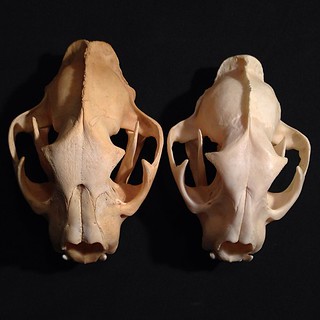
These are my two Mountain Lion skulls. The natural body oils are very apparent on the specimen on the left. The golden coloration is a dead give away that it was never properly processed. Some factors to keep in mind though: yellow can also mean that it was once boiled or chlorine bleach was used in the processing. So avoid both of those things! You can not undo bone that was yellowed by chlorine bleach. It may appear white at first but over time it will yellow. A full rolling boil will draw grease deeper into the bone rather than making it rise to the surface. Once done it is very hard to degrease. Last factor to consider is that the skull on the left was sold to me as "antique". I will be attempting to properly processing this skull in the near future. Only then will I know the true answers to the history of this skull. The skull on the right is still mildly greasy to the eye & touch but not so bad that I feel the need to degrease. Degreasing is a step in bone processing that is purely for preference to the bone collector. I honestly rarely need to degrease anything because it gets mostly taken care of during maceration. With experience you will be able to tell by touch, color and weight if you need to degrease.
For long term preservation, too much oil in bone is bad because bacteria can turn grease into acid and thus damage the bone. But at the same time, 100% grease free makes bone more fragile because grease is a part its natural components and sometimes bones can even shrink a little. A little grease left in bone is best for the longest preservation. I was told by a university teacher that some museums stopped to degrease fully and whiten specimens devoted to research. Now they only do the total bone degreasing for displayed specimens that will not be handled at all. So keep this in mind when deciding on whether you want to degrease or not. I have absolutely noticed a difference in quality of the bones I will or won't use in my jewelry. If they have been fully degreased they just don't seem to be up for being a wearable piece of art that could take daily wear. They also have very little weight which is not good for say a pendant for example.
More related extensive info here:
Whitening Bone Using Hydrogen Peroxide NOT Chlorine BleachBad Words: BOIL & BLEACH
The Mathematics Of Maceration - A HowTo Guide For The Impatient
A HowTo Guide For My Crock Pot Methods



16 comments:
So what is the best way to degrease the bones in order to remove most of the grease for jewelry making
Hi Tyler, As I mentioned above I very rarely have to degrease any bones. I'm fortunate to be in a fairly warm climate and between the natural decomposition and maceration processing I do I'm left with very little grease in my bones. So I don't honestly have much experience in degreasing because I do not often have the need. Many bone collectors literally let their already macerated bones then sit in a bath of water and dish soap. It is a long process. Grease slowly rises to the surface. If the water gets too cloudy/greasy a new soapy bath it made. This can take literally months. Similarly you can make a degreasing bath with ammonia and water. But note that there is very low content of water to ammonia. Too much ammonia can harm the bone structure. Sorry, I don't know the exact ratio at this moment. I will try to experiment with this stuff and do a blog post at some point but that's the best I can do right now.
I as well macerate so haven't really degreased in awhile but recently I was gifted a Javelina skull and holy hell is it greasy. I have it in dawn right now but I've heard about acetone and ammonia do either work as good as people say?
Those skulls are known to take literally months to degrease. You could try lightly heating the soapy water to accelerate the process. I've found the ammonia process to me a long one as well. Acetone degreasing is really best for smaller skulls. And can still take months. If you rarely degrease I'd honestly stick to soap/water or highly diluted ammonia/water. It will just take a lot of patience. Swapping out the baths we they start looking cloudy/grease saturated. Good luck!
Yea I heard they take forever lol Was going to simmer it but I'll just stick to soap and water. It's always sunny in California so hopefully that helps it while it's outside. Thanks again (:
Hello! I was recently gifted an old bison skull by a shaman to adorn with henna. Im excited by the prospect but want to show the skull respect as well as apply proper treatment to prepare for my art. As a beginner looking at the skull it appears very old and greying around the eye sockets and horns. However the underside of the skull is very dirty (I cannot tell if it is dust or bio particles leftover from whatever procrossing it went through). The underside is the only piece that may have grease on it. So, do I macerate in water just to be safe and see if anything comes from it? Or do I go right to the hydro bath? There is literally no fur, hide, or tissue left but its hard for me to tell if there isnt something in the underside or not. Also, because the age of thia skull is unknown to me, will maceration/hydro bath damage old bones?
Thank You!
-Cora
Ps-Im now obsessed with your work. Incredible
Hi Cora! It honestly sounds like you just need to hose off the skull and scrub the dirst off. May take some water soaking first so try not to get the horn sheaths wet if there are any, or just remove them if you can. After than you can try a peroxide bath but it may not do much. If the bone is very grey it is likely very nature cleaned and it wudn't do much at all. Good luck! jana
I have been learning to process bones in the last couple of months. I was curious if greasy bones might feel sticky or tacky on the surface. Most are fine, but quite a few bigger bones are slowly developing a slightly tacky feel to the touch. Everything was nature cleaned before I found it, so there was no maceration left to do. I put the bones in a soap and water bath until no more grease came to the top before putting them in a whitening bath. I'm still slightly unsure if they are greasy and if the amount of grease left would hinder the adhesive I use to adorn them. Really trying to avoid making something I love, just to have the grease dissolve all the adhesive and it all fall apart anyway. I read an article about the grease literally decaying adhesives and potentially ruining the piece months or years later. I'd really appreciate any guidance.
Thanks, Jana!
-Kayla
Hi Kayla! Properless processed bone should never feel taky to the touch, but dry instead. So that sure sounds like grease to me. I would just keep degreasing and doing a followup peroxide bath. Good luck! jana
Great post! I do a lot of bone blanks out of cow femur bone preparation for my instrument repair business. Bear in mind cow bone is really really greasy. I boil them just to get the marrow out and cook the tissue. Beatles do the rest. I start macerating with dish soap in a dark bucket left out in the sun. I replace water and detergent every four days. This takes about a month. Then I wash and dry them for a few days. Next step is simmering in an oven at 60deg C for at least 10hrs. Wash, dry completely and repeat as necessary. Lastly when my bone is fully degreased (like 90%) I give it a wash in naphtha and then alcohol. When all this is done and bones are dry I rub mineral oil on my blanks. I need a greasy bone so that strings can glide easily on a bone guitar nut, but animal fat is not only detrimental to bone itself, it destroys wood and glue joints even faster. Mines look nice and more ivoriod in colour but competitors who only boil them for hours upon hours have thrm yellow out of the box and after a couple of years it starts to develop a greenish tint and smells awfully. Maybe someone find this one useful. I try to get as much of the animal fat out as possible while supplementing it with mineral oil.
Forgot to add - I never use any bleaching agents or ammonia, but I am still getting it 'museum white'.
Thanks gybe! A couple things to note that may help your processing go faster and be less greasy. When you boil your draw the grease further into the bone. And by adding soap to your maceration step you are killing the bacteria that do the maceration work, or are preventing them from growing all together. I literally use tap water in my maceration tub along with the bones themselves, that is it. Usually takes no more than 3 weeks to finish and move onto the peroxide bath. I don't do any kind of heated processing as it draws grease inward and can weaken the bone structure. I love that you create your own bone parts for instruments, that's dedication!
Hey there, I know you don't degrease often but maybe you've come across this- the bones I'm degreasing, some have turned light and can tell they are grease free- while others are a shade of dark pink/purple? I'm not sure what happened- if they need to stay in the soap bath longer or if they stayed in too long? It's not a film that I can get off either. Any information would help, thanks!
Hi Mackenzie Austin… All I can suggest is to keep degreasing and whitening and repeat until it is gone. I would let it dry between each step. Good luck… jana
Hi Jana,
Great work and thank you for your blog!
I have a bison jaw bone that I'm degreasing - i think! I have no experience doing this. The bone was purchased at a powwow and hasn't been processed much. There is still "brown" on the teeth, tartar? the bone is better looking and smelling since i degreased it. It was in the bucket with soap and water, covered for about 6 weeks. I just poured out the cloudy water this morning and set the bone in the garage to dry. Should I go to the hydrogen peroxide phase now? I'd like to send you a pic so you can give me your opinion... possible?
Any advice you can give would be great!
Mel
Hi Mel! Bad smell is normal, it is the grease. After degreasing you want to followup with a hydrogen peroxide bath. See m,y blog posts on that topic. It will further pull out grease. For what/dish soap degreasing you want to pour out the water every time it gets cloudy/grease and repeat until it in no longer cloudy. So you may need moire degreasing. Or you may like how it looks after the peroxide bath. good luck!
Post a Comment